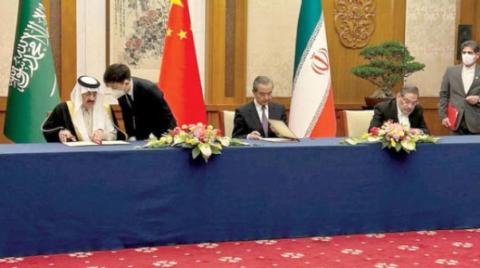
It is commonly accepted, by both his opponents and many his supporters, that US President Donald Trump’s performance in Helsinki last week was disappointing. Standing next to Russian President Vladimir Putin, the usually pugnacious Trump looked docile. The press conference oscillated from the unbelievable to the cringeworthy— and made for uncomfortable watching throughout.
While it is true that Trump did not seem to “give” anything away to Russia, it is also true that he did not fight for anything at the press conference. One thing is certain: he missed an excellent opportunity to press Putin on many of Russia’s indiscretions around the world, whether they be in Ukraine, Georgia or Syria.
During the press conference, a lot of focus was given to the Middle East – predominately regarding Syria and Iran.
This focus on the Middle East has not gone unnoticed. One camp thinks that if only the US and Russia could get along, then they could work together to solve big international problems like the Syrian civil war or nuclear proliferation.
This is wishful thinking.
The inconvenient truth is that Russia and the US share the same common interests in the Middle East in the same way a robber and a customer share the same common interests in a bank.
Take Syria, for example.
During the press conference, Syria was mentioned no less than 18 times. There was a sense by both leaders that Syria is a place where the US and Russia can and should cooperate. However, this is wrong for three reasons.
Firstly, nothing since coming to power in 1999 shows that Putin can be a trusted partner for the US. Putin has spent almost two decades trying to undermine the US and its allies at every turn. Putin has given no reason why Syria would be any different.
Secondly, if past behavior is anything to go by, Russia cannot be trusted to live up to any ceasefire agreement in Syria. A decade after a six-point ceasefire agreement ended the war in Georgia, Moscow is still not in full compliance. The Minsk 2 ceasefire in eastern Ukraine is only a ceasefire in name, with daily violations by Russian-backed forces. Moscow has made a complete mockery out of the de-escalation zone in southern Syria negotiated last year by the US, Jordan and Russia. So why would anyone reasonably believe that Putin would live up to any new ceasefire commitments?
Finally, there is a huge gap between what the US hopes to achieve in Syria and what Russia sees as success. The top goals for the US in Syria are the defeat of Daesh and preventing Iran from using Syria to grow its regional influence.
The inconvenient truth is that Russia and the US share the same common interests in the Middle East in the same way a robber and a customer share the same common interests in a bank.
Luke Coffey
For Moscow, the top goal is keeping Assad or someone like him in power to maintain Russia’s military presence in Syria. Without the Russian naval base in Tartus and the use of the Hmeimim Air Base, Russia is merely a regional power and not a global power – Putin knows this.
Another goal for Moscow is to frustrate US policy in Syria – to make it that much more difficult for the US to achieve its goals so more American resources and focus are placed on Syria and not in other places of Russian interest like in Eastern Europe.
Put simply, the White House and the Kremlin’s goals are not compatible for any meaningful collaboration.
As if Syria was not enough challenging for US-Russia relations in the Middle East, there is also the issue of Iran and its imperial ambitions in the region. This is another area where the US and Russia have two completely different objectives.
Unlike with Syria, the differences regarding Iran were actually made clear in the press conference. Whereas Putin was talking about the nuclear deal making Iran “the most controlled country in the world,” President Trump said he would “halt its [Iran’s] nuclear ambitions and to stop its campaign of violence throughout the area, throughout the Middle East.”
Russia is Iran’s greatest enabler. Moscow provides diplomatic top cover for Iran on the international stage and is Tehran’s biggest defender on the United Nations Security Council. Even so, there seems to be a lack of understanding about Moscow’s ability to influence Iran’s behavior in Syria. The US should not think that cooperation with Russia could marginalize Iran’s sway in Syria.
This is also why Israel’s latest overtures to Russia are so curious. If Israeli Prime Minister Benjamin Netanyahu cracks a deal with Putin because he thinks that Russia can force Iran out of Syria, he will be sorely disappointed. Iran’s investment in blood and treasure in Syria since 2011 has been too great, and its links to the Assad family too deep, for anyone to believe that Moscow can easily push the Tehran out of the country.
Since Putin’s audacious intervention in Syria there has been a lot of talk about Russia replacing the US as the premier outside power in the Middle East. This is nonsense. By supporting Assad and enabling Iran, Russia is not doing its relationships with Sunni Arab countries any favors. Beyond a relationship based on pragmatism, it is hard to see Russia deepening its cooperation with the rest of the Middle East outside Syria and Iran in any meaningful way.
Because of the different goals in Syria, Moscow’s coziness to Tehran and the overall untrustworthiness of Putin’s regime for the US, it is also nonsense to suggest that after Helsinki a US-Russia rapprochement can be found in the Middle East.
Putin would love nothing more than to convince Trump that Russia can be a credible partner for the US in Syria.
Trump should not fall for it.
Luke Coffey is Director of the Douglas and Sarah Allison Center for Foreign Policy at the Heritage Foundation. Twitter: @LukeDCoffey
Disclaimer: Views expressed by writers in this section are their own and do not necessarily reflect Arab News" point-of-view












